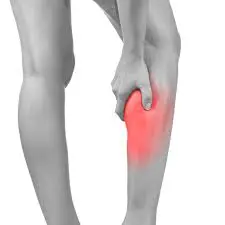How to Drive Smartly Without Worsening Your Neck Pain
Introduction
Driving with neck pain can be a challenging experience, making even routine tasks seem like a daunting ordeal. Whether it’s due to a recent injury or a chronic condition, taking measures to ensure a more comfortable driving experience becomes crucial.
This article offers insights into smart driving practices and simple adjustments that can significantly alleviate discomfort and minimize the risk of exacerbating the pain. By incorporating these strategies, individuals can navigate the roads with greater ease and reduce the impact of neck pain on their daily lives.
You’re the one dealing with traffic and inattentive drivers. You cannot sleep like your passengers; you must be attentive and tense at all times. To top it all off, you experience neck aches when you drive.
Long-distance driving is a leading cause of neck discomfort. It doesn’t just impact those who go on road trips; truckers and taxi drivers are also at significant risk of developing neck discomfort because they are constantly behind the wheel.
Neck pain can be a major distraction while driving, making it difficult to focus on the road and react to hazards.
If you have neck pain, it is important to take steps to stay safe while driving.
Neck pain can make driving difficult and dangerous. It can limit your range of motion, making it difficult to turn your head and check your blind spots.
It can also cause pain and discomfort, distracting you from the road.
What is Neck Pain?
- Neck pain is a typical complaint that a mixture of various health disorders can induce. It can vary from mild to severe, with more extreme cases possibly implying a severe underlying issue.
- Your neck and upper back (cervical spine) consist of seven vertebral bones that keep your head. These bones are divided by vertebral discs & are reinforced by a network of muscles and ligaments (connective tissue). A difficulty with any of these structures, or nerves in or near your neck, can induce neck pain.
- Mild to moderate neck pain can usually be treated at home and improves within a couple of weeks, but it’s necessary to seek quick medical awareness if you develop severe neck pain unexpectedly due to harm, such as after a car accident or a fall.
- You should also consult a healthcare provider if, in addition to neck pain, you’re also experiencing numbness or loss of power in your arms or hands or shooting pain down your arm.
Cause of Neck Pain while driving
A significant part of people encounter neck pain. While it can be induced by trauma or medical conditions, it can also be due to stress and pressure on the muscles that keep the neck, or to the nerves or bones in the neck.
Specific movements that can result in a stiff neck include keeping your head in an extended position and utilizing your arms and upper body for long periods that’s a pretty reasonable description of driving a car.
Most of us get to work by driving. Here are some tips for lowering tension and neck pain throughout the commute there and back, since you probably already have enough stress to deal with once you arrive at work.
Several elements can contribute to neck pain while driving, including:
- Poor posture: This is the most common cause of neck pain while driving. Slouching or craning your neck forward puts strain on the muscles and ligaments in your neck.
- Repetitive movements: Turning your head to check your blind spots, looking behind you, or parallel parking can strain your neck muscles.
- Vibration: The vibration from the road can also contribute to neck pain, especially if you have a stiff neck or a history of neck injuries.
- Whiplash: Whiplash is a neck injury that can occur in a car accident. It happens when the head is suddenly jerked back and then forward. Headaches, stiffness, and neck pain can all be symptoms of whiplash.
- Arthritis: Arthritis can cause inflammation and pain in the joints in your neck. This can make neck pain worse while driving.
- Herniated disc: A herniated disc is a condition in which the soft, cushioning material between the vertebrae in your spine leaks out. This may create pain by applying pressure to the nerves in your neck.
- Muscle tension: Stress and anxiety can cause muscle tension in your neck, which can lead to pain.
Other possible causes of neck pain while driving include:
- Poor seat adjustment: If your seat is too high or too low, or if the steering wheel is too close or too far away, it can strain your neck.
- Headrest misalignment: If your headrest is not adjusted correctly, it can strain your neck.
- Carrying heavy objects: Carrying heavy objects in the car, such as a purse or briefcase, can put strain on your neck and shoulders.
- Using mobile devices while driving: Using a mobile phone or other electronic device while driving can cause you to crane your neck forward, which can lead to pain.
If you experience neck pain while driving, it is important to see a doctor to rule out any underlying medical conditions. Once the cause of your pain is identified, your doctor can recommend the appropriate treatment.
Signs and Symptoms of Neck Pain
The signs and symptoms of neck pain while driving can vary from person to person, but some common symptoms include:
Neck discomfort may be accompanied by the following symptoms:
- Persistent aching
- Stabbing pain
- Tenderness or sensitivity to mild pressure
- Pain that worsens when you keep your head in one position for a long period
- Muscle tightness or spasms.
- Dull, aching pain in the neck
- Muscle stiffness or spasms
- Difficulty moving the head
- Headache
- Shoulder pain
- Pain that radiates down the arms or hand (Tingling and numbness)
- Neck pain can be acute (lasting a few days to a few weeks) or chronic (lasting more than three months to many years).
Diagnoses for Neck Pain
To diagnose neck pain while driving, your doctor will start by asking you about your symptoms and medical history. They will also perform a physical examination, which will include checking your range of motion, muscle strength, and nerve function.
- Medical history: Your provider will ask about prior neck injuries that may have induced whiplash or a herniated disk. They may ask about your profession or other workouts that could strain your neck. They’ll ask about your discomfort, including when it was initiated, where it’s discovered, how prolonged it lasts, and how extreme it is.
- Physical exam: Your provider will check your head and neck alignment and watch your range of motion when you drive your neck. They’ll sense your neck and supporting muscles to check for tenderness and symptoms of strain.
If your physician presumes that you may have an underlying medical disorder, such as arthritis or a herniated disc, they may advise imaging tests, such as an X-ray or MRI.
- X-rays: X-rays can show issues with your bones or soft tissues that may be inducing neck aches. An X-ray can reveal issues with cervical alignment, fractures, and slipped disks, and they can notice arthritis.
- MRI(Magnetic resonance imagine): An MRI can reveal difficulties with your spinal cord, nerves, bone marrow, and soft tissue. It can display if a disk has slipped out of position, symptoms of infection, and masses that may be generating neck pain, like a cyst or tumor.
- Computed Tomography: A CT scan may be utilized if an MRI isn’t available. It can display bone spurs and signs of bone decomposition.
In some cases, your doctor may also call nerve conduction studies or electromyography (EMG) tests. These tests estimate the electrical activity of your nerves and muscles.
- Electrodiagnostic tests: These tests inspect the function of nerves and your muscle reaction. Tests contain nerve conduction studies and, rarely, a myelogram if an MRI is contraindicated.
- Lab tests: These tests can assist your provider in recognizing causes of neck pain other than musculoskeletal damages, like infections, rheumatological disorders, or cancers. Tests contain a complete blood count (CBC), urinalysis, and markers of inflammation, among others.
Once your doctor has analyzed the cause of your neck pain, they can suggest proper treatment.
Treatment for Neck Pain
The goals of neck pain treatment are to:
- Reduce pain and inflammation
- Improve range of motion and flexibility
- Strengthen the neck muscles
- Prevent further injury
- Restore function and quality of life
Your doctor will recommend therapies to alleviate your symptoms, such as:
- Muscle relaxants and pain relievers: Nonsteroidal anti-inflammatory medicines (NSAIDs) to relieve neck pain and inflammation, as well as muscle relaxants to aid in the healing of neck muscles, are frequent first-line therapies for neck discomfort.
- Physical therapy: You may work with a physical therapist or a fitness trainer to learn exercises and motions that will strengthen and stretch the muscles and tendons in your neck.
- TENS unit: A TENS unit transmits a low-level electrical current to your skin near your nerves to interrupt the pain signal, producing discomfort. Before utilizing a TENS device, always consult with your doctor.
- Injections of steroids: A dose near the nerve roots can lessen inflammation and pain.
- Alternative therapies: Your clinician may offer acupuncture to ease pain or massage to assist in relaxing tight muscles that are causing you difficulty. You might consult a neurologist or a physical therapist to correct your spine.
- Surgery: The majority of reasons for neck discomfort don’t require surgery. Even so, if one or more of your vertebrae have slipped out of place or are placing pressure on your nerves, you may require surgery.
Exercise for Neck Pain while driving
Some find themselves sitting in the car every day, and maybe several times a day. If you have neck ache or stiffness, you must do the following neck stretches in the car.
The aim of a stretch
- A stretch’s goal is to maintain a position for a longer length of time. This can assist in enhancing your range of motion over time.
- When you do the exercise, you should feel some slight stretch. This should not be painful or unpleasant. If possible, hold stretches for 20 to 30 seconds.
Neck Forward flexion (forward bend)
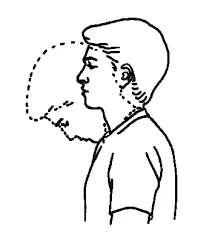
- Maintain a straight back and relaxed shoulders while seating.
- Slowly tuck your chin towards your chest, keeping your back straight and your neck long.
- Hold the stretch for 15-30 seconds
- Gradually return to the starting position.
- Repeat 2-3 times.
Neck Rotations

- Neck rotations are a great way to keep the muscles in your neck loose and flexible.
- To perform this exercise, sit comfortably and slowly move your head to the right.
- Hold for a few seconds before rotating to the left.
- This should be done 10 times in every direction.
Lateral Neck Flexion Stretch
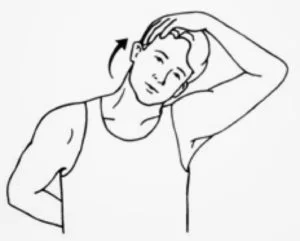
- Bend your neck as if you were bringing your left ear towards your left shoulder, using your hand to gently provide overpressure while keeping your nose pointed forward.
- Hold on to a seat to make the stretch more powerful. You should feel a stretch in your neck on the same side as you are holding the chair. Rep on the right side.
- Maintain the stretch for 30 seconds. This exercise will help you enhance your neck mobility.
Neck Tilts / Neck Side flexion

- Neck tilts are an excellent technique to lengthen the sides of your neck.
- To perform this exercise, sit or stand comfortably and tilt your head to the right.
- Hold for a few seconds before moving your head to the left.
- This should be done 10 times in every direction.
Neck Extensions
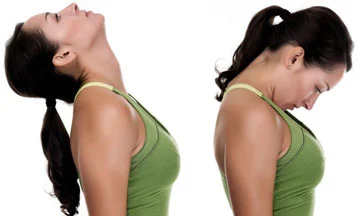
- Seated neck extensions are an excellent technique to lengthen the back of your neck.
- Sit up straight, then slowly tilt your head back for a few seconds before releasing.
- This should be done ten times.
Chin tucks

- Sit with your back straight while keeping your head held high.
- Slowly tuck your chin towards your chest, hold for a few moments, and then gradually return to the starting position.
- Repeat 10-15 times.
Upper trapezius stretch

- The upper trapezius stretch is an excellent approach to relaxing the upper trapezius muscle, which is positioned on the back of the neck and shoulders.
- This muscle is frequently utilized for repetitive actions like sitting at a computer or driving, and as a result, it can get tight and uncomfortable.
- Follow these instructions to execute the sitting upper trapezius stretch:
- Place your back straight and your shoulders relaxed in a seat.
- Place your right hand directly over your ear on the left side of your head.
- Tilt your head to the right, applying slight pressure with your palm.
- Hold the stretch for 10-15 seconds, or until you feel the tension release.
- Repeat on the opposite side.
Levator scapulae stretch
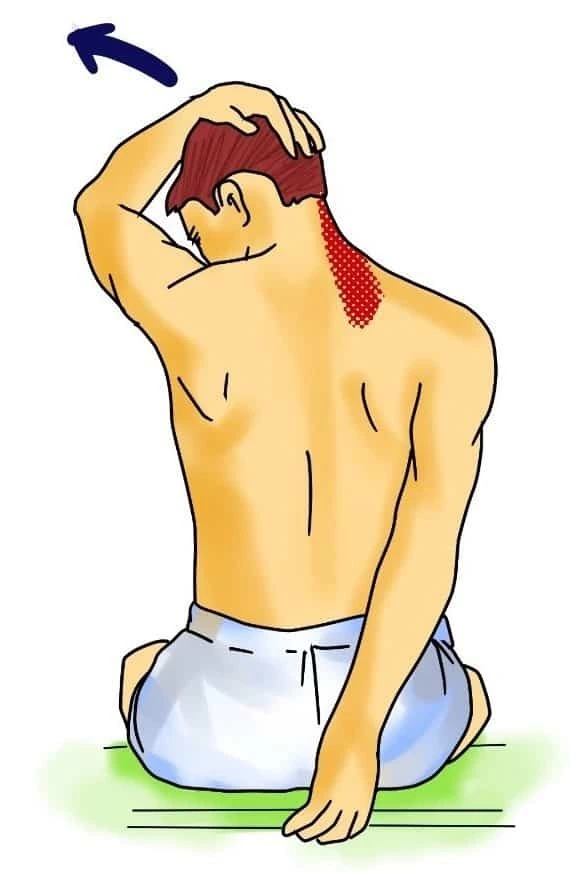
- Maintain a straight back and relaxed shoulders.
- Place your right hand on your head, and gently tilt your head to the right.
- Pull your head gently in the direction of your left shoulder using your left hand.
- Maintain your back straight and your chin level.
- After holding the stretch for 15 to 30 seconds, switch to the other side.
These 7 neck stretches are easy to do in the car and can help relieve neck pain and tension. Remember to take deep breaths throughout every exercise and to stop if you experience any pain. With regular practice, these stretches can help improve your posture and keep your neck muscles strong and healthy, and you can able to drive pain-free.
When should these stretches performed?
- At intersections with traffic lights
- Waiting to pick up a child from school, training, sports, or parties, among other things.
- On the rail, tram, or bus (rather than only in the motorcar)
- Taking a seat on the couch with a high back
Driving Smart to Avoid Neck Pain
The strain induced by concentrating extremely on driving can contribute to neck aches. You can bypass neck pain by modifying what you do before you begin your drive and adjusting how you drive.
- Start with good driving posture. The best angle for the back of your seat is 100 degrees, which is just shy of straight. Place your hands in the 3 and 9 o’clock places on the steering wheel and tilt your steering wheel so that your wrists are straight and your elbows are slightly bent.
- Support your head. Your headrest should be adjusted such that it rests on the center portion of your back. To support your head and neck, use a neck cushion.
- Support your lower back. If the lumbar support on your car seat is available, use it to fill up the space at your lower back; if not, the proper form from the tailbone to the neck can be maintained by placing a small cushion against the bottom of the seat back. Also, make certain your seat is near sufficiently to the steering wheel so that you don’t hold to tilt forward.
- Adjust your mirrors. With all of your mirrors, give yourself the largest possible field of vision so you won’t need to turn your head to see well.
- Avoid eyestrain. When you drive while having poor vision, you may strain your eyes and strain your neck muscles by raising your neck forward. If you find yourself struggling to see while driving, you should have your eyesight examined. To see clearly, make sure your vehicle’s windscreen is clean. If you’re driving in bright sunlight, use sunglasses with at least 99% UV protection.
- Cruise along the highway. With cruise control, you may put your feet up and relieve some of the strain on your back when traveling long distances.
- Take a break. If you start to get a stiff neck, are feeling neck pain, or want to prevent it, pull into the next rest stop. Stretch and take a stroll to walk to eliminate the aches.
- Avoid movement: Avoid repetitive movements, such as turning your head to check your blind spots or to look behind you. Avoid slouching or craning your neck forward while driving.
- If you have a history of neck injuries or neck pain, talk to your doctor about how to safely drive.
To Adjust your driving position for Neck Pain relief
Follow these steps
- Adjust your seat height. Your seat should be high enough so that you can comfortably reach the pedals and steering wheel. Your thighs should be parallel to the ground and your feet should be able to rest flat on the floor.
- Adjust the backrest angle. Your backrest should be reclined slightly so that your shoulders are relaxed and your head is held in a neutral position.
- Adjust the headrest. The headrest should be positioned so that the top of it is level with the top of your head and the back of it supports the middle of your head.
- Adjust the steering wheel. The steering wheel should be adjusted so that your elbows are slightly bent and your wrists are straight when you grip them at the 9 and 3 o’clock positions.
What can you do to treat Neck Pain at home?
In addition to using pain relievers, you can reduce neck discomfort at home by doing the following:
- Hot therapy: Every few hours, take a hot shower or apply a hot towel or heating pad on the spot of your discomfort for 15 minutes. The heat loosens your muscles and improves blood circulation.
- Cold therapy: Apply a cold pack or a bag of frozen vegetables for 15 minutes every few hours (covered in a small towel to protect your skin). The cold causes your blood vessels to constrict, lowering inflammation and swelling. Immediately after an injury, use cold instead of heat.
- Exercise: Follow the advice of your medical provider’s recommendations for neck exercises to reduce neck discomfort and increase range of motion. If you have a major neck injury or a pinched nerve, avoid doing exercises.
- Stress reduction techniques: Mindfulness, meditation, breathing exercises, and yoga can assist in the release of stress in your body, which may lead to neck discomfort.
- Quit smoking: Smoking affects bone structure, increases degenerative disc disease, and delays recovery.
FAQs
Why does driving hurt my neck?
If you sit too far back, you will almost certainly strain your neck forward. Constantly tensing your neck muscles will result in neck discomfort and upper body stiffness.
Should I drive with a neck pillow?
A specifically constructed car neck cushion can help alleviate headaches and neck strain. When driving for a period, a high-quality neck pillow is necessary. A neck pillow can help with muscular tension relief and posture correction in addition to its original usage as a sleeping aid.
Can driving result in a pinched nerve in the neck?
Whiplash can cause muscular strains and sprains because your neck is thrown around so violently that the muscles are stretched beyond their usual range of motion. These muscles’ inflammation may exert pressure on surrounding nerves, resulting in a pinched or compressed nerve.
How can I resolve my neck ache quickly?
Treatment and home cures for neck pain
Apply either heat or ice.
Take pain medicines that are available over-the-counter (OTC).
Stretch, but don’t move too quickly.
Consult with a physical therapist (PT).
A massage.
Acupuncture is an option.
Limit physical activities that cause neck pain.
Reference
- Phillips, Q. (2023, February 7). What is neck pain? Symptoms, causes, diagnosis, treatment, and prevention. EverydayHealth.com. https://www.everydayhealth.com/neck-pain/
- Professional, C. C. M. (n.d.-b). Neck pain. Cleveland Clinic. https://my.clevelandclinic.org/health/symptoms/21179-neck-pain
- Errolstchiro. (2021, September 26). Neck Stretches to do in the Car –. https://errolstchiro.com.au/neck-stretches-to-do-in-the-car/
- Sharma, D. K. (2019, November 22). 7 Tips for Comfortable Car Driving & Prevent Back/neck Pain. https://www.practo.com/healthfeed/7-tips-for-comfortable-car-driving-prevent-back-neck-pain-39787/post






